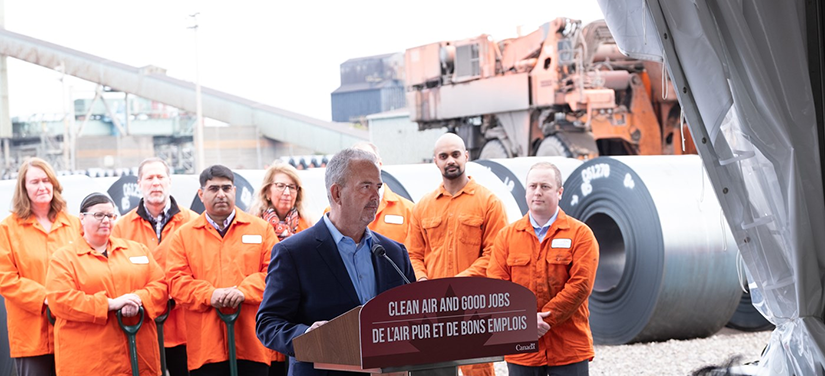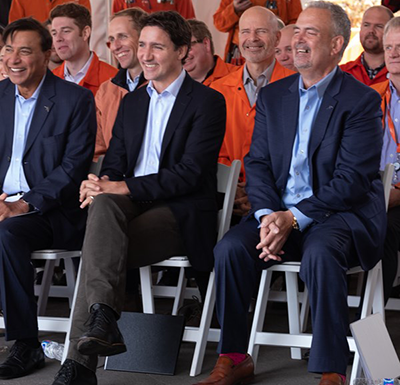
ArcelorMittal Dofasco breaks ground on low-carbon emissions steelmaking project
Mike Edwards
News People in Process ArcelorMittal decarbonization Dofasco DRI-EAF green hydrogen steel production
ArcelorMittal has broken ground on its $1.8 billion investment decarbonization project at the ArcelorMittal Dofasco plant in Hamilton, ON.
The project will fundamentally change the way steel is made at ArcelorMittal Dofasco, transitioning the site to direct reduced iron-electric arc furnace (DRI-EAF) steelmaking, which carries a considerably lower carbon footprint and removes coal from the ironmaking process.
The new 2.5 million tonne capacity DRI furnace will initially operate on natural gas but will be constructed ‘hydrogen ready’ so it can be transitioned to utilize green hydrogen as a clean energy input as and when a sufficient, cost-effective supply of green hydrogen becomes available.
The project, a partnership between ArcelorMittal and the governments of Canada and Ontario, which was first announced in July last year, will play an important role in ensuring the company makes progress this decade with its decarbonization efforts and is part of ArcelorMittal’s target to reduce the carbon intensity of the steel it produces by 25% by 2030.
The governments of Canada and Ontario have committed $400 million and $500 million respectively to the overall project cost.

ArcelorMittal Chairman, Lakshmi Mittal (left), Prime Minister Justin Trudeau, and ArcelorMittal Dofasco president and CEO, Ron Bedard were among the luminaries present at the groundbreaking. Also in attendance: Minister of Innovation, Science and Industry, François-Philippe Champagne; Minister responsible for the Federal Economic Development Agency for Southern Ontario, Filomena Tassi; Minister of Families, Children and Social Development, Karina Gould.
ArcelorMittal Dofasco president and CEO, Ron Bedard (above) said: “This project provides us with a tremendous opportunity to transition ArcelorMittal Dofasco into one of the world’s cleanest, lowest carbon and modern steel manufacturers.
“While it involves installing new technology and equipment, the investment is really about people and planet. It will help our customers lower their carbon footprint, ensuring they deliver low carbon products to consumers.”
Since the project was initially announced last year, ArcelorMittal Dofasco has established a dedicated project team to manage its transition, completed significant pre-front end engineering and design (pre-FEED) work as well as analysis of the equipment needed for its transformation.
Today, the Hamilton team shared updates on the projects progress including news that ENERGIRON, the innovative direct reduction technology jointly developed by Tenova S.p.A. and Danieli & C. S.p.A., has been chosen as its DRI equipment. It will produce 2.5 million tonnes of DRI per year to be used in Hamilton’s EAFs to produce the most demanding steel grades. The DRI plant will be the largest single-module direct reduction plant in Canada.
The first onsite construction work will begin in January 2023, with the demolition of the decommissioned No.1 Coke Plant to make room for the new DRI plant. Demolition is anticipated to take up to nine months to complete.
Also in 2023, detailed engineering work will be undertaken before foundation work begins in 2024. Construction will become visible from outside the manufacturing campus in 2024 as the structures begin to take shape. Construction on the new assets will be complete in 2026, at which point a 12 to 18-month transition phase will begin with both steelmaking streams (BF-BOF and DRI-EAF) active. The transition will be complete by 2028.
In addition to the new DRI facility, the project also involves the construction of an EAF capable of producing 2.4 million tonnes of high-quality steel through ArcelorMittal Dofasco’s existing casting, rolling, and finishing facilities. Modification of ArcelorMittal Dofasco’s existing EAF facility and continuous casters will also be undertaken to align productivity, quality, and energy capabilities between all assets in the new footprint.
Print this page